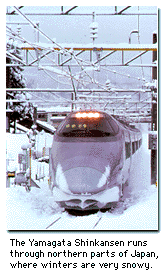During regular operation, Shinkansen, or bullet trains, can reach speeds
of up to 300 kilometers (186 miles) per hour. There are plans to raise this
limit to around 330 kph to 350 kph (205 mph to 217 mph) in the near future.
The Shinkansen was inaugurated in 1964, the year of the Tokyo Olympic Games.
It operated for 515 kilometers (319 miles) between Tokyo and Osaka via Nagoya.
In 1975 the line was extended southwest to Fukuoka, Kyushu, more than doubling
the total length to 1,069 kilometers (663 miles).
 Two
new lines were introduced in 1982: a 497-kilometer (308-mile) route from
Tokyo to Morioka (extended to Hachinohe in 2002) in the northeast, and a 342-kilometer (212-mile) stretch
from Tokyo to northwestern Niigata along the Sea of Japan coast. And in
1992 the northeastern route gained a new link between Fukushima and Yamagata (extended to Shinjo in 1999).
Two
new lines were introduced in 1982: a 497-kilometer (308-mile) route from
Tokyo to Morioka (extended to Hachinohe in 2002) in the northeast, and a 342-kilometer (212-mile) stretch
from Tokyo to northwestern Niigata along the Sea of Japan coast. And in
1992 the northeastern route gained a new link between Fukushima and Yamagata (extended to Shinjo in 1999).
Yet another new line has been built to link Tokyo with Nagano, which hosted the Olympic Winter Games in February 1998. There is also a plan to cover the entire nation with a network of bullet train lines.
The Shinkansen was designed to provide a high-speed means of transporting large numbers of people over long distances. They proved popular not only among business workers but also tourists. For this reason, dining cars and cars with special compartments for families and groups have been introduced. The trains are now equipped with pay telephones.
In recent years, a growing number of people have begun using the Shinkansen to commute to work. To meet the demands for more seats, "double-decker" cars have been introduced.
Bullet trains are operated with the most advanced technology available to guarantee efficiency and safety. There are systems to automatically and centrally control the trains' speed and the distance between trains, and the trains can be stopped or slowed in emergencies.